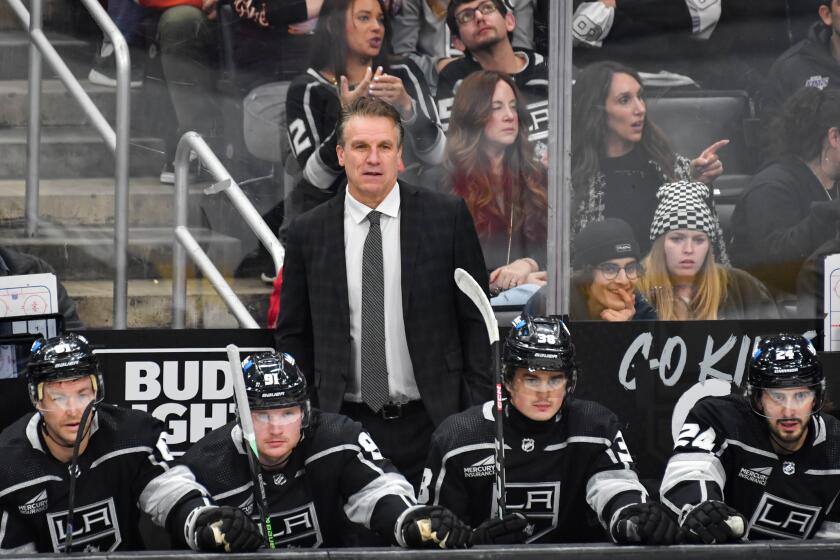Raiders Will Rock You on KLSX-FM : Radio: Finding that demographics of NFL fans mirror its own, station joins trend of FM outlets that get a payoff from football link.
Sundays will be (silver and) Black Sabbath this fall on Los Angeles classic-rock radio station KLSX-FM (97.1), which signed on last month as the flagship for the Raiders’ radio network.
Pro football and classic rock might seem an odd coupling--the staid NFL has been called the No Fun League--but KLSX is among a growing number of FM stations across the country that have aligned themselves with NFL teams.
The Raiders, who ended a six-year association with KFI-AM (640) after last season, are one of nine NFL teams that list an FM station as their primary outlet, and several other NFL teams broadcast their games on an AM-FM simulcast.
“Football is the perfect companion for a classic-rock station,” said Bob Moore, general manager at KLSX.
But it’s not only classic-rock stations that have bid millions of dollars for NFL radio rights.
A country station has been the Tampa Bay Buccaneers’ flagship since 1991. Adult-contemporary stations are the major outlets for the Arizona Cardinals and Dallas Cowboys. And a talk station recently signed on to be the Washington Redskins’ main station.
*
Many of the FM stations that have bid on radio rights for NFL teams have found that the demographics of their listeners often mirror those of football fans, who tend to be young and male.
“You’ve got a lot of general managers out there who see sports as a way to higher ratings,” said Neil Cutler, a Los Angeles-based radio consultant. “It’s a way to introduce people to their station and, hopefully, keep their butts there the rest of the week.”
But FM stations have mostly shied away from professional baseball, basketball and hockey, experts say, because the time commitment required to broadcast those sports is disruptive to all other programming. In normal seasons, major league baseball teams play 162 games, NHL teams play 84 and NBA teams play 82, not including exhibitions.
The 16-game NFL schedule--played mostly on Sundays when radio listenership is traditionally at its lowest--is a much better fit for FM, which over the last 25 years has grown more music-oriented than AM and has tripled its share of the audience in the process. Surveys show that about 75% of radio listeners tune to FM.
“There’s been a philosophy in our industry to never break the programming on FM--let it run like a music machine--but we seem to have gotten away from that philosophy a little bit and decided that major events like football do not necessarily hurt the format, particularly when they’re run on a Sunday,” said Jim Duncan, editor of Duncan’s Radio Market Guide. “Sunday is kind of a dead time--usually, your Sunday audience levels bring down the rest of the week--so you can get a boost from football.”
*
KLSX’s Moore, who had pursued the Raiders since December, is confident that football will greatly increase the station’s audience on Sundays, as well as provide it with untold marketing and promotional opportunities.
“We’ll be very visible wherever the Raiders play,” he said.
Moore’s enthusiasm was important to the Raiders, who had worked with him when they aired their games on KLSX’s AM sister station, KRLA, from 1985-88.
Said Al LoCasale, the Raiders’ executive assistant: “It’s very important to feel important--to feel like you mean a lot to them in their plans, in their marketing and in their march to greater success.”
KLSX, in addition to possible midweek programming, will devote at least seven hours of air time to the Raiders each Sunday during the season, including pregame and postgame shows. The game-day broadcasts will have a “rock ‘n’ roll tone,” Moore said.
The station, which charges about $300-$400 for a 30-second commercial spot during regular programming, will charge as much as $2,700 for the same spot during Raider games, Moore said. At the same time, however, KLSX, which signed a multiyear deal with the Raiders, will pay more than $1.5 million a year in rights fees to the team.
“I don’t think many FM stations will make significant profits on their investment in the NFL,” Duncan said. “They get big grosses for carrying sports, but the expenses are such that it’s difficult to make serious profit money.”
Instead, Duncan said, FM stations broadcast the NFL for the prestige and the promotional and marketing value of being aligned with a popular team.
Ron Chapman, program manager at KVIL in Dallas, said that his station broadcasts the Cowboys “not because we are a sports station but because we are a station that reflects the market. And in this market, there is nothing bigger than a Cowboy game.”
In Los Angeles, the Raiders don’t carry the same cachet as the Cowboys do in Dallas, but “I think it’s a very good move by Bob Moore to link KLSX with the Raiders,” Cutler said. “Certainly, there are going to be a lot of people sampling his radio station who just may leave that button on.”
*
That was the thinking in 1985 when the Houston Oilers signed with easy-listening station KODA-FM, becoming the first NFL team to make an FM station its exclusive radio network flagship.
“It took some selling to get the Oilers used to the idea, but it was demographically compatible,” said David Pearlman, who was general manager at KODA when he negotiated the deal with the Oilers.
Among Pearlman’s selling points was that the high-fidelity nature of FM, with its full stereo capability, offered a different kind of listening experience to NFL fans.
“We really promoted that very heavily,” said Pearlman, who is co-chief operating officer for Boston-based American Radio Systems. “We had a whole campaign of urging listeners to turn down their TV sets and bring up the volume on their stereos.”
Within a year, Pearlman said, listenership on KODA had doubled.
KCFX-FM in Kansas City, which has been the Chiefs’ flagship since 1990, also has enjoyed its affiliation with the NFL.
Hoping to attract a younger audience, the Chiefs switched from AM radio to the classic-rock FM station after several mediocre seasons had eroded much of the team’s support and kept new customers away from Arrowhead Stadium.
“It just wasn’t hip at that time to be a Chiefs fan, and we could give them a hip image and a new audience base in the 25-44 age group,” said Bill Newman, KCFX general manager. “The average season ticket-holder before they aligned themselves with us was about 49 years old. Today it’s 34.”
Listener response has been “phenomenal,” Newman said.
“My station usually ranks No. 1 in the market in the fall among adults 25-54, which is our target,” he said. “Kansas City is a market of 1.2 million people, and I’ll have as many as 600,000 who will sample the station during the Chiefs’ game in an average week. I couldn’t spend $1 million for advertising and get that kind of sampling.”
More to Read
Get our high school sports newsletter
Prep Rally is devoted to the SoCal high school sports experience, bringing you scores, stories and a behind-the-scenes look at what makes prep sports so popular.
You may occasionally receive promotional content from the Los Angeles Times.






